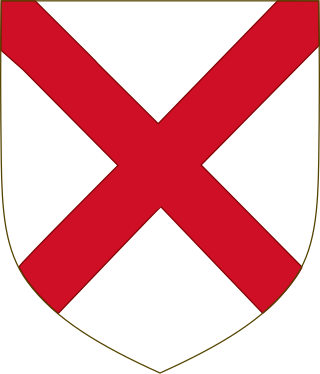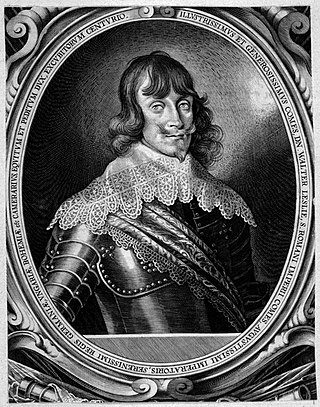
1634 (MDCXXXIV) was a common year starting on Sunday of the Gregorian calendar and a common year starting on Wednesday of the Julian calendar, the 1634th year of the Common Era (CE) and Anno Domini (AD) designations, the 634th year of the 2nd millennium, the 34th year of the 17th century, and the 5th year of the 1630s decade. As of the start of 1634, the Gregorian calendar was 10 days ahead of the Julian calendar, which remained in localized use until 1923.

Lieutenant-General James FitzThomas Butler, 1st Duke of Ormond, KG, PC, was an Anglo-Irish statesman and soldier, known as Earl of Ormond from 1634 to 1642 and Marquess of Ormond from 1642 to 1661. Following the failure of the senior line of the Butler family, he was the second representative of the Kilcash branch to inherit the earldom.

Albrecht Wenzel Eusebius von Wallenstein, also von Waldstein, was a Bohemian military leader and statesman who fought on the Catholic side during the Thirty Years' War (1618–1648). His successful martial career made him one of the richest and most influential men in the Holy Roman Empire by the time of his death. Wallenstein became the supreme commander of the armies of the Imperial Army of Holy Roman Emperor Ferdinand II and was a major figure of the Thirty Years' War.

Johann Reichsgraf von Aldringen was an Austrian soldier active before and during the Thirty Years' War.

Vice-Admiral Thomas Butler, 6th Earl of Ossory, KG, PC, PC (Ire) (1634–1680) was an Irish soldier and politician. He was the eldest son of James Butler, 1st Duke of Ormond but predeceased his father and therefore never succeeded as duke.

Ottavio Piccolomini, 1st Duke of Amalfi was an Italian nobleman whose military career included service as a Spanish general and then as a field marshal of the Holy Roman Empire.

The FitzGerald dynasty is a noble and aristocratic dynasty of Cambro-Norman and Anglo-Norman origin. They have been peers of Ireland since at least the 13th century, and are described in the Annals of the Four Masters as having become "more Irish than the Irish themselves" or Gaels, due to assimilation with the native Gaelic aristocratic and popular culture. The dynasty has also been referred to as the Geraldines and Ireland's largest landowners. They achieved power through the conquest of large swathes of Irish territory by the sons and grandsons of Gerald de Windsor. Gerald de Windsor was the first Castellan of Pembroke Castle in Wales, and became the male progenitor of the FitzMaurice and FitzGerald Dynasty. His father, Baron Walter FitzOther, was the first Constable and Governor of Windsor Castle for William the Conqueror, and was the Lord of 38 manors in England, making the FitzGeralds one of the "service families" on whom the King relied for his survival.

Prince Hans Ulrich von Eggenberg was an Austrian statesman, a son of Seyfried von Eggenberg, Lord of Erbersdorf (1526–1594), and great-grandson of Balthasar Eggenberger. He was a prominent member of the House of Eggenberg and gained the title of Duke of Krumau.
Sir George Hamilton, 1st Baronet of Donalong and Nenagh, was born in Scotland, but inherited land in Ireland. Despite being Catholic, he served his Protestant brother-in-law, the 1st Duke of Ormond, lord lieutenant of Ireland, in diplomatic missions during the Confederate Wars and as receiver-general of the royalists. He also defended Nenagh Castle against the Parliamentarians during the Cromwellian conquest of Ireland. Hamilton was father of Anthony, author of the Mémoires du Comte de Grammont, of Richard, Jacobite general, and of Elizabeth, "la belle Hamilton".
Richard Butler, 3rd Viscount Mountgarret (1578–1651) was the son of Edmund Butler, 2nd Viscount Mountgarret and Grany or Grizzel, daughter of Barnaby Fitzpatrick, 1st Baron Upper Ossory. He is best known for his participation in the Irish Confederate Wars on behalf of the Irish Confederate Catholics.
Thomas Butler, Viscount Thurles was the son and heir apparent of Walter Butler, 11th Earl of Ormond (1559–1633), whom he predeceased. He lived at the Westgate Castle in Thurles, County Tipperary. He was accused of treason but drowned in a shipwreck off the Skerries in the Irish Sea, before he could be judged. He was the father of the Irish statesman and Royalist commander James Butler, 1st Duke of Ormonde.
Walter Butler of Ballinakill Castle, Roscrea was a military officer, who served as a colonel (Oberst) in the Imperial Army under Albrecht von Wallenstein and was involved in Wallenstein's assassination in 1634.

Count Walter Leslie was a Scottish soldier and diplomat. He gained the positions of Imperial Field Marshal, Count of the Holy Roman Empire, Governor on the Croatian-Slavonian Military Frontier, Imperial Ambassador to Naples, Rome in 1645 and to Constantinople in 1665–1666.

Elizabeth Poyntz (1587–1673), known as Lady Thurles, was the mother of the Irish statesman and Royalist commander James Butler, 1st Duke of Ormonde.
Carey or Cary Dillon, 5th Earl of Roscommon, PC (Ire) (1627–1689) was an Irish nobleman and professional soldier of the seventeenth century. He held several court offices under King Charles II and his successor King James II. After the Glorious Revolution he joined the Williamite opposition to James and was in consequence attainted as a traitor by James II's Irish Parliament in 1689. In that year he fought at the Siege of Carrickfergus shortly before his death in November of that year.

Christian von Ilow was a Neumark nobleman and Generalfeldmarschall who fought during the course of the Thirty Years' War. At the outbreak of the war, Ilow enlisted into the Imperial army, rapidly advancing through the lower ranks. Through his close association with Imperial Generalissimo Albrecht von Wallenstein, he attained the rank of Generalfeldmarschall. He was killed in Eger on 25 February 1634 along with the general and his loyal officers the assassination being the culmination of an internal purge of Wallenstein's supporters.

Adam Erdmann Trčka von Lípa was a Bohemian nobleman and lieutenant field marshal, who fought during the course of the Thirty Years' War. He became a close associate of Imperial Generalissimo Albrecht von Wallenstein. He was killed along with other loyal officers and Wallenstein himself, in the so-called Eger Bloodbath, a culmination of the internal purge within the Holy Roman army.
The Assassination of Wallenstein was the culmination of an internal purge in the army of the Holy Roman Empire. On 25 February 1634, a group of Irish and Scottish officers acting under the approval of Ferdinand II, Holy Roman Emperor, assassinated generalissimo Albrecht von Wallenstein and a group of his companions in the town of Eger. The assassins were equated to executioners by a royal decree and rewarded with property confiscated from the families of their victims. The purge continued through the persecution of other high-ranking military personnel who were seen as Wallenstein's supporters.
John Hamilton, was an Irish army officer of Scottish and Irish origin, who fought in the Williamite war in Ireland on the side of the deposed James II. He died from wounds received at the Battle of Aughrim.

Elizabeth Butler, Duchess of Ormond and 2nd Baroness Dingwall reunited the Ormond estate as her maternal grandfather, Black Tom, 10th Earl of Ormond had it, by marrying James Butler, later Duke of Ormond, her second cousin once removed. She had inherited her share of the Ormond estate through her mother, Elizabeth Preston, who was Black Tom's daughter and only surviving child. Her husband had inherited his share from his grandfather Walter Butler, 11th Earl of Ormond, Black Tom's successor in the earldom. Her share was the bigger one and included Kilkenny Castle.











